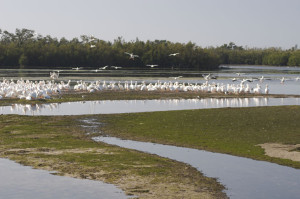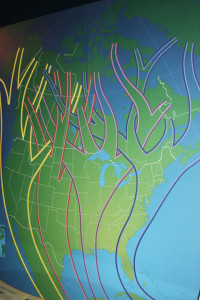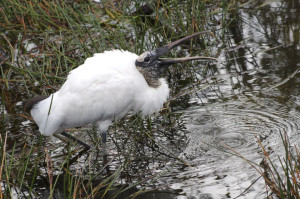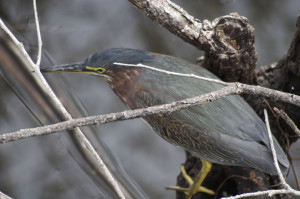The photographer, wearing multiple cameras, walked towards me grinning.
Cameras with long lenses worth more than the national debt of medium-sized third world countries hung from each shoulder.
“Well how is it?” I asked, holding just one camera in one hand.
The “it” we both understood – is “it” a good day for shooting wildlife pictures?
His response: “It doesn’t get any better than this.”
He walked away and I moved towards the cluster of people gawking at the road’s edge on Wildlife Drive. He was right. Birds, birds, birds everywhere. It doesn’t get any better than this. Get out the cameras. Dial in the binoculars.
It was low tide on a bright winter’s day at J. N. “Ding” Darling National Wildlife Refuge on Sanibel Island. Low tide attracts wintering wading birds that gravitate to the small pools of water and the fish trapped in them. Long lines of white pelicans graced the mud flats. Herons stood in the water. A pair of park volunteers set up a long lens telescope. People took turns seeing the great views.
The Great Florida Birding Trail has both birds and wildlife
This is just one stop on the Great Florida Birding & Wildlife Trail, maintained by the Florida Fish and Wildlife Conservation Commission. The trail covers 2,000 miles all over the state and has 515 birding and wildlife viewing spots. Guides to different areas of the trail are free and available on line and at state parks.
Winter doesn’t just bring people with out of state license plates to Florida. Birds fly in. Now is the time for bird watching made easy as birds congregate for sun and fun. But hurry, birds have a way of flying away without filing flight plans.
Think I’m kidding about birds migrating with the seasons? Have a look at this bird migration map from the visitor center at Ding Darling.
Sandhill cranes , lovely tall long-necked birds, like to winter along the wetlands at Paynes Prairie Preserve State Park near Gainesville. As long as the weather stays cool, they stay around, but when it warms up, off they go. A walk on the La Chua Trail with a ranger, or a trail guide like Lars Andersen of Adventure Outpost or on your own is always fun – this walk is one of five Gainesville walks in my e book “10 Florida Great Walks Around Gainesville and Ocala”
In mid-February the first egrets will start arriving at St. Augustine Alligator Farm Zoological Park. They pay no admission. A choice location is reserved for their maternity stay – the bird rookery in tall cypress trees overlooking the park’s wetlands. It evolved by chance but has now become a must see destination.
By mid-March breeding season is in full swing. Expect to find photographers from all over the world with tripods set up on the boardwalk. It is a chance to get up close and personal with nesting Florida birds.
The rookery is so popular it has its own blog in the park’s web site and you can get rookery updates by calling (904) 824-3337, ext. 23.
The Great Florida Birding Trail covers 2,000 miles all around the state
Wood Storks head for Corkscrew Sanctuary in Naples for nesting, though they have failed to produce families in recent years. The ancient bald cypress attracts them. A walk along the elevated boardwalk always has good bird sightings. On my last visit a little green heron perched on a railing. Everyone stopped walking. Photographers came forward, took pictures then stepped back and more shutterbugs stepped up. When all were satisfied someone must have cued the heron that the photo op was over. He flew away. People walked on. I thought this is such a wonderful leisurely way to be a birder.
Inside Everglades National Park in Homestead the Anhinga Trail, a mere one-quarter mile through the sawgrass, offers bird viewing that doesn’t need long lenses. It is especially fine in the winter months – read the chapter Anhinga Amble in my book 50 Great Walks in Florida.
The Great Florida Birding Trail is a resource that serves the whole state. See their calendar of upcoming events for birding festivals like the Orlando Wetlands Festival on Feb. 16 and the Southwest Florida 11th Annual Burrowing Owl Festival in Cape Coral on Feb. 23.
There is a dynamic, intimate and vital connection between birds and water. Audubon Florida’s Development Director Margaret Spontak shares her thoughts on that connection:
Water and Birds: They are So Connected
Talking about the connection between water and birds reminds me of one of my favorite quotes from John Muir, “When we try pick out anything by itself, we find it hitched to everything else in the Universe.” This is so true of so many environmental issues, but particularly the strong link between water and birds. The decline in many bird species can be linked in part to the reduction in water quality and quantity.
Wildlife needs water for so many different reasons. The most obvious is for drinking. But others include digestion and metabolism, housing or nesting, shallow wetlands providing concentrated food sources, bathing to reduce body temperature, and migratory resting places. In fact, wildlife can only survive a few days without water. Water sources should be available every ½ mile or so. And, many birds make journeys that are almost unfathomable.
Birds and wildlife are suffering from water-related impacts such and loss of habitat, historic wetland loss, salt water intrusion, drought, water quality degradation and mismanagement of water levels. There are many state and federal laws that prevent reduction in water quality and quantity, but many of those are not being adequately enforced. Some of the most notable are the Clean Water Act, Federal and State Endangered Species Act, and State Water Policy. (For a list go to http://edis.ifas.ufl.edu/uw076)
YOU can help protect water for birds and other wildlife by doing the following:
Be a role model by reducing fertilizer use, maintaining septic tanks, and reducing water use
Learn about more about water and bird conservation
Support funding for acquisition of conservation lands
Connect others with nature to help build a conservation ethic
Make your own yard bird and wildlife friendly
Volunteer as a conservation volunteer
Become an active advocate speak up
Contribute your support to a conservation group
Learn more about wildlife needs, birds and water, at http://www.audubonofflorida.org
And read Audubon of Florida news here
MORE TO EXPLORE
Be languid at Warm Mineral Springs in North Port
Birds of a feather flock together



